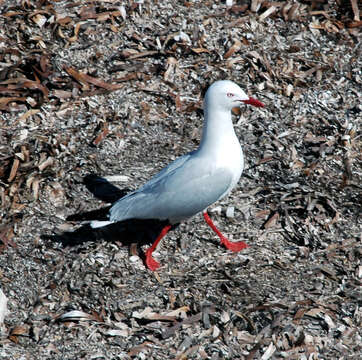Larus novaehollandiae (silver gull) (Port Pirie, South Australia)

Description:
Description: English: Larus novaehollandiae Stephens, 1826 - silver gull on beach at Port Germein jetty, Port Pirie, southern South Australia on 18 August 2006. Gulls (Family Laridae) consist of over four dozen living species. They have medium-sized bodies, webbed feet, and are aquatic & terrestrial. They are nearly omnivorous, but prefer predation and scavenging. Despite their reputation for being seabirds (sea gulls), they remain near coastlines and are often found far inland. Apart from a slight size difference between the sexes, gulls are not sexually dimorphic. Juveniles differ considerably from adults in plumage patterns and coloration. The silver gull has a red beak, red legs, white eyes, and black wingtips. Classification: Animalia, Chordata, Vertebrata, Aves, Charadriiformes, Laridae Birds are small to large, warm-blooded, egg-laying, feathered, bipedal vertebrates capable of powered flight (although some are secondarily flightless). Many scientists characterize birds as dinosaurs, but this is consequence of the physical structure of evolutionary diagrams. Birds aren’t dinosaurs. They’re birds. The logic & rationale that some use to justify statements such as “birds are dinosaurs” is the same logic & rationale that results in saying “vertebrates are echinoderms”. Well, no one says the latter. No one should say the former, either. However, birds are evolutionarily derived from theropod dinosaurs. Birds first appeared in the Triassic or Jurassic, depending on which avian paleontologist you ask. They inhabit a wide variety of terrestrial and surface marine environments, and exhibit considerable variation in behaviors and diets. Date: 17 August 2006, 22:55:55. Source: https://www.flickr.com/photos/47445767@N05/15579499232/. Author: James St. John.
Included On The Following Pages:
- Life (creatures)
- Cellular (cellular organisms)
- Eukaryota (eukaryotes)
- Opisthokonta (opisthokonts)
- Metazoa (Animal)
- Bilateria
- Deuterostomia (deuterostomes)
- Chordata (Chordates)
- Vertebrata (vertebrates)
- Gnathostomata (jawed fish)
- Osteichthyes
- Sarcopterygii (Lobe-finned fishes)
- Tetrapoda (terrestrial vertebrates)
- Amniota (amniotes)
- Reptilia (Reptiles)
- Diapsida (diapsid)
- Archosauromorpha (archosauromorph)
- Archosauria (Archosaurs)
- Dinosauria (dinosaurs and birds)
- Saurischia
- Theropoda (theropods)
- Tetanurae (tetanuran theropod)
- Coelurosauria (coelurosaur)
- Maniraptoriformes
- Maniraptora (maniraptoran)
- Aves (birds)
- Ornithurae
- Neornithes
- Neognathae (Neognaths)
- Neoaves
- Charadriiformes (shorebirds and relatives)
- Laridae (gulls, terns, and skimmers)
- Chroicocephalus (Hooded gulls)
- Chroicocephalus novaehollandiae (Silver Gull)
This image is not featured in any collections.
Source Information
- license
- cc-by-3.0
- copyright
- James St. John
- creator
- James St. John
- source
- James St. John (47445767@N05)
- original
- original media file
- visit source
- partner site
- Wikimedia Commons
- ID


